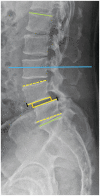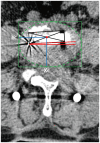What Affects Segmental Lordosis of the Surgical Site after Minimally Invasive Transforaminal Lumbar Interbody Fusion?
- PMID: 35748078
- PMCID: PMC9226838
- DOI: 10.3349/ymj.2022.63.7.665
What Affects Segmental Lordosis of the Surgical Site after Minimally Invasive Transforaminal Lumbar Interbody Fusion?
Abstract
Purpose: This study was undertaken to identify factors that affect segmental lordosis (SL) after minimally invasive transforaminal lumbar interbody fusion (MIS-TLIF) by comparing patients whose postoperative SL increased with those whose decreased.
Materials and methods: Fifty-five patients underwent MIS-TLIF at our institute from January 2018 to September 2019. Demographic, pre- and postoperative radiologic, and cage-related factors were included. Statistical analyses were designed to compare patients whose SL increased with decreased after surgery.
Results: After surgery, SL increased in 34 patients (group I) and decreased in 21 patients (group D). The index level, disc lordosis, SL, lumbar lordosis, proximal lordosis (PL), and Y-axis position of the cage (Yc) differed significantly between groups I and D. The cage in group I was more anterior than that in group D (Yc: 55.84% vs. 51.24%). Multivariate analysis showed that SL decreased more significantly after MIS-TLIF when the index level was L3/4 rather than L4/5 [odds ratio (OR): 0.46, p=0.019], as preoperative SL (OR: 0.82, p=0.037) or PL (OR: 0.68, p=0.028) increased, and as the cage became more posterior (OR: 1.10, p=0.032).
Conclusion: Changes in SL after MIS-TLIF appear to be associated with preoperative SL and PL, index level, and Yc. An index level at L4/5 instead of L3/4, smaller preoperative SL or PL, and an anterior position of the cage are likely to result in increased SL after MIS-TLIF.
Keywords: Minimally invasive; cage; lumbar lordosis; outcome; segmental lordosis; spine surgery; transforaminal lumbar interbody fusion.
© Copyright: Yonsei University College of Medicine 2022.
Conflict of interest statement
The authors have no potential conflicts of interest to disclose.
Figures





Similar articles
-
Does interbody cage lordosis impact actual segmental lordosis achieved in minimally invasive lumbar spine fusion?Neurosurg Focus. 2020 Sep;49(3):E17. doi: 10.3171/2020.6.FOCUS20393. Neurosurg Focus. 2020. PMID: 32871566 Free PMC article.
-
Minimally invasive transforaminal lumbar interbody fusion with expandable versus static interbody devices: radiographic assessment of sagittal segmental and pelvic parameters.Neurosurg Focus. 2017 Aug;43(2):E10. doi: 10.3171/2017.5.FOCUS17197. Neurosurg Focus. 2017. PMID: 28760032
-
Assessment of radiographic and clinical outcomes of an articulating expandable interbody cage in minimally invasive transforaminal lumbar interbody fusion for spondylolisthesis.Neurosurg Focus. 2018 Jan;44(1):E8. doi: 10.3171/2017.10.FOCUS17562. Neurosurg Focus. 2018. PMID: 29290133
-
Restoration of lumbar lordosis after minimally invasive transforaminal lumbar interbody fusion: a systematic review.Spine J. 2019 May;19(5):951-958. doi: 10.1016/j.spinee.2018.10.017. Epub 2018 Dec 6. Spine J. 2019. PMID: 30529420
-
Assessing the Difference in Clinical and Radiologic Outcomes Between Expandable Cage and Nonexpandable Cage Among Patients Undergoing Minimally Invasive Transforaminal Interbody Fusion: A Systematic Review and Meta-Analysis.World Neurosurg. 2019 Jul;127:596-606.e1. doi: 10.1016/j.wneu.2019.03.284. Epub 2019 Apr 5. World Neurosurg. 2019. PMID: 30954733
Cited by
-
Comparative Outcomes of Biportal Endoscopic Decompression, Conventional Subtotal Laminectomy, and Minimally Invasive Transforaminal Lumbar Interbody Fusion for Lumbar Central Stenosis.Neurospine. 2024 Dec;21(4):1178-1189. doi: 10.14245/ns.2448830.415. Epub 2024 Dec 31. Neurospine. 2024. PMID: 39765263 Free PMC article.
-
The Clinical Use of Osteobiologic and Metallic Biomaterials in Orthopedic Surgery: The Present and the Future.Materials (Basel). 2023 May 10;16(10):3633. doi: 10.3390/ma16103633. Materials (Basel). 2023. PMID: 37241260 Free PMC article. Review.
References
-
- Tian H, Wu A, Guo M, Zhang K, Chen C, Li X, et al. Adequate restoration of disc height and segmental lordosis by lumbar interbody fusion decreases adjacent segment degeneration. World Neurosurg. 2018;118:e856–e864. - PubMed
-
- Brodano GB, Martikos K, Lolli F, Gasbarrini A, Cioni A, Bandiera S, et al. Transforaminal lumbar interbody fusion in degenerative disk disease and spondylolisthesis grade I: minimally invasive versus open surgery. J Spinal Disord Tech. 2015;28:E559–E564. - PubMed
-
- Lee WC, Park JY, Kim KH, Kuh SU, Chin DK, Kim KS, et al. Minimally invasive transforaminal lumbar interbody fusion in multilevel: comparison with conventional transforaminal interbody fusion. World Neurosurg. 2016;85:236–243. - PubMed
MeSH terms
LinkOut - more resources
Full Text Sources

